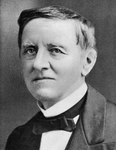The United States Presidential Election of 1876, the 23rd U.S. presidential election, took place on November 7, 1876. Democrat Samuel J. Tilden soundly defeated James G. Blaine and Roscoe Conkling despite only getting 45.9% of the popular vote.
Background[]
The second term of George H. Pendleton had proven to be an eventful and heated time in the United States. Pendleton largely focused his second term on establishing warmer relations with the Confederacy, a move that he thought would be popular with the war-tired populace. His actions actually had the opposite effect, and his meeting with C.S. President Stonewall Jackson on July 4, 1876, turned the country against his administration. This energized the base of the young National and American Parties and gave them a real chance of winning the election. There was a movement to unite the two parties into one, but it fell through when they could not agree on a single candidate.
Democratic Nomination[]
The Democratic National Convention took place on June 27-July 2, 1876, in St. Louis. With Pendleton leaving office and victory once again seeming ripe for the taking (despite Pendleton's mistakes), many candidates lined up for a shot at the presidency. The three main candidates were Governor Samuel J. Tilden of New York, Thomas A. Hendricks of Indiana, and Senator Thomas F. Bayard of Delaware. Tilden was famous for cleaning up the rampant corruption in New York's political system, and it was thought that a fresh face like him would help the public forget about President Pendleton's policies. Hendricks and Bayard also had significant support. Tilden would end up winning the nomination on the 6th ballot when Hendricks agreed to drop out in exchange for the vice presidential nomination.
National Nomination[]
The National Party Nominating Convention took place from July 4-9, 1876, in Chicago. James G. Blaine won the nomination almost unopposed; he had agreed in 1875 to run again for the party, despite his sour feelings from the last election. Oliver P. Morton of Indiana was nominated for vice president.
The convention coincided with the infamous meeting of President Pendleton with Confederate President Jackson. When news of this reached the convention, the floor was said to have gone into an angry frenzy. On the flip side, party leaders knew they had their chance to bring the National Party to national prominence.
American Nomination[]
The American Party National Convention took place from July 23-30 in Boston. The party was energized from the outrage caused by President Pendleton; they knew they had to capitalize with a strong candidate. There was a large movement within the party to nominate James G. Blaine for president, thus uniting the American and National Party tickets against Tilden. Party leaders saw differences between the two parties and weren't quite ready to unify, so they pushed hard for any other candidate. Eventually, it came down to Blaine and Roscoe Conkling of New York. A deal was struck that allowed Conkling to win the nomination. As part of this deal, National Party vice presidential candidate Oliver P. Morton was nominated as the American vice presidential candidate.
The Campaign[]
Both Blaine and Conkling's campaigns lambasted the Democrats for being Southern sympathizers and traitors. For the first time since the end of the war, the American people were developing a strong anti-Confederacy sentiment and supported the opposition parties' platforms of opposing them. Neither party had much to say against Tilden, who had maintained a clean record. They instead mostly attacked Pendleton, who never responded to the provocations. The Democrats pointed to how they had rebuilt America and saved it from falling apart. The opposition parties claimed that all they were doing was turning the U.S. into a Northern Confederacy. This struck a chord with the American people.
Results and Aftermath[]
The energized anti-Democrat base was enough to limit Tilden to 45% of the popular vote. However, the existence of two opposition parties divided the vote enough for Tilden to win in an electoral landslide. If the parties had both nominated Blaine, he probably would've won with 53% of the popular vote. The National and American Parties were greatly disappointed by the results and realized their mistake in not unifying. Oliver P. Morton, as the candidate of both parties, won 69 electoral votes for vice president, although this was not enough to earn the position.
The results of this election pushed the opposition parties to think strongly about a merger; this was officially accomplished when they joined in 1879 to form the National American Party. Tilden promised to stray clear of Confederate influence, and he kept true to his promise for his whole first term. Despite the anti-Democratic wave, Tilden proved to be quite a popular president. His strong morality and eloquence greatly endured him to Americans on all sides. With Tilden's personal popularity contrasting with the continuing desire to overthrow the Democrats, 1880 was shaping up to be a battle of massive proportion.
| ||||||||||||||||||||




